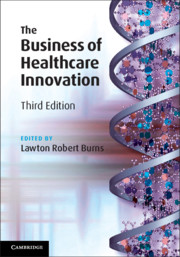Book contents
- The Business of Healthcare Innovation
- Reviews
- Other Cambridge Volumes
- The Business of Healthcare Innovation
- Copyright page
- Dedication
- Contents
- Figures
- Contributors
- Preface
- Acknowledgments
- 1 Product Suppliers in the Healthcare Value Chain
- 2 The Pharmaceutical Sector
- 3 The Biotechnology Sector: Therapeutics
- 4 New Venture Creation in Biotechnology
- 5 The Medical Device Sector
- 6 Financing Medtech Innovation
- 7 The Healthcare Information Technology Sector
- Index
2 - The Pharmaceutical Sector
Published online by Cambridge University Press: 24 February 2020
- The Business of Healthcare Innovation
- Reviews
- Other Cambridge Volumes
- The Business of Healthcare Innovation
- Copyright page
- Dedication
- Contents
- Figures
- Contributors
- Preface
- Acknowledgments
- 1 Product Suppliers in the Healthcare Value Chain
- 2 The Pharmaceutical Sector
- 3 The Biotechnology Sector: Therapeutics
- 4 New Venture Creation in Biotechnology
- 5 The Medical Device Sector
- 6 Financing Medtech Innovation
- 7 The Healthcare Information Technology Sector
- Index
Summary
Strategy and structure in the current biopharmaceutical industry are a legacy of business conditions that no longer exist. As conditions change, strategy and structure must adapt. The typical large biopharmaceutical company accounts for a tiny (about 1 percent, and shrinking) share of total global biomedical innovation, yet fills its development portfolio with its own internal discoveries. Companies are spending heavily on their own leads, rather than on the best leads, with resulting high failure rates in late stage development. Companies often insist on manufacturing their products in-house, leading to low asset utilization rates, under-investment in new manufacturing technologies, and volatile gross margins. Pressure on gross margins is amplified by the recent and relatively sudden loss of real US pricing power. Communicating product attributes to patients, physicians, and payors has shifted from traditional one-way (e.g., print, TV, radio) media in which companies could control messaging to two-way (e.g., Internet, social media) channels in which companies’ voices must share bandwidth with other points of view. These and other profound changes in biopharmaceutical companies’ operating environment call for similarly profound changes in strategy and structure. The challenges are significant, but entirely addressable, and in several cases, successful transitions in other industries (e.g., integrated circuits, film) may be instructive.
Keywords
- Type
- Chapter
- Information
- The Business of Healthcare Innovation , pp. 31 - 88Publisher: Cambridge University PressPrint publication year: 2020

